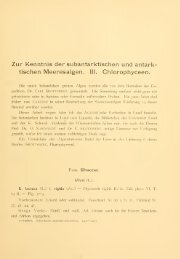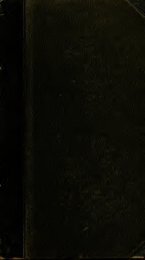Download PDF
Download PDF
Download PDF
Create successful ePaper yourself
Turn your PDF publications into a flip-book with our unique Google optimized e-Paper software.
wall.<br />
United States: Texas, Karnac, April 27, 1938.<br />
SPIROGYRA 197<br />
In this collection the outer spore wall was much larger than the median<br />
179. Spirogyra taylorii Jao 1935. Trans. Amer. Micros. Soc. 54,<br />
p. 4, PL I, Figs. 2-3.<br />
Vegetative cells 12-16(1 x (48-) 70-193 ju,, with plane end walls; i<br />
chromatophore, making 2.5 to 6 turns in the cell; conjugation scalar-<br />
iform; tubes formed by the male gametangia; fertile cells inflated<br />
toward the middle and usually more on the conjugating side, up to<br />
33 /-i; zygospores ellipsoid, 19-29;". x 39-45 /x; median spore wall finely<br />
reticulate to punctate, yellowish-brown at maturity. (PI. XXXIII,<br />
Fig- 9-)<br />
United States: Massachusetts, Woods Hole.<br />
The fertile cells are continuous in the filaments, not separated as in the<br />
next species. Named for W. R. Taylor, University of Michigan, author of<br />
Marine Algae of the Northeastern Coast of North America and many contributions<br />
to both fresh-water and marine phycology.<br />
180. Spirogyra liana Transeau 1934. Trans. Amer. Micros. Soc.<br />
53, p. 228.<br />
Vegetative cells 11-16/J. x 75-160/^1, with plane end walls; i chro-<br />
matophore, making 2 to 6 turns; conjugation scalariform and lateral;<br />
tubes formed wholly by the male gametangia; inflated single or paired<br />
fertile cells usually separated by i to 5 nonconjugating cells; zygospores<br />
ellipsoid, 23-^0 m x 35-50 m; median spore wall yellow, smooth. (PI.<br />
XXXIII, Figs. 1(^11.)<br />
China, Szechwan and Kiangsi; Sweden.<br />
Named for Liang Ching Li, Fan Memorial Institute, Peiping, China.<br />
This is one of the smallest of the species with plane end walls in which the<br />
conjugating tubes are formed by the male gametangia. In most of these<br />
species (Nos. 177 to 197), the conjugating cells are arranged singly or in<br />
pairs with one to several intervening nonconjugating cells. At the inception<br />
of conjugation, food substances accumulate in these gametangia and they<br />
become darker green and filled with starch grains. At the same time the<br />
intervening cells become lighter green and the chromatophores become<br />
thinner and narrower. This group of species may be designated the "punc-<br />
tata group" after the first of these species to be described.<br />
S. hydrodictya (No. 177) has these same characteristics and has in<br />
addition the compressed-spherical spores characteristic of the "majuscula<br />
group" of species. This species illustrates one of the difficulties in the path<br />
of anyone who attempts to subdivide the genus Spif-ogyra on the basis of<br />
tube formation or spore form.<br />
Among the replicate species of Spirogyra there is a corresponding group




